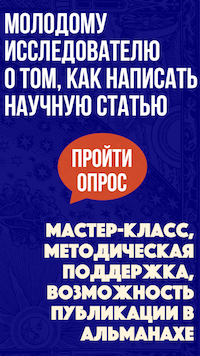МОЛОДЁЖНЫЙ ПРОЕКТ ДЛЯ ТЕХ, КТО ДЕЛАЕТ ПЕРВЫЕ ШАГИ В НАУКЕ
/components/bitrix/system.auth.form/auth_alm/images/login.gif) Войти
Войти /components/bitrix/system.auth.form/auth_alm/images/register.gif) Регистрация
Регистрация
Войти в корпоративную почту как автор/член редколлегии/рецензент журнала




ТЕОРИИ, КОНЦЕПЦИИ, ПАРАДИГМЫ / THEORIES, CONCEPTIONS, PARADIGMS / THEORIEN, KONZEPTIONEN, PARADIGMEN
Исследование влияния объектов различной геометрии и из различных материалов на рассеяние нейтронов
Литература
Блохин А.И., Демин Н.А., Чернов В.М. Нейтронные источники для исследования конструкционных материалов // Вопросы атомной науки и техники. Серия: Материаловедение и новые материалы. 2006. № 1. С. 70—87.
Гуревич М.И., Шкаровский Д.А. Расчет переноса нейтронов методом Монте-Карло по программе MCU: Учебное пособие. М.: НИЯУ МИФИ, 2012. 154 с.
Кутеев Б.В., Гончаров П.Р., Сергеев В.Ю., Хрипунов В.И. Мощные нейтронные источники на основе реакций ядерного синтеза // Физика плазмы. 2010. Т. 36. № 4. С. 307—346.
Лебедев В.Т., Лебедев В.М. Исследование надатомной структуры облученных образцов реакторных конструкционных материалов на основе сплавов алюминия методом малоуглового рассеяния нейтронов с использованием аппарата пространственных корреляционных функций. Отчет по программе фундаментальных исследований Отделения физических наук РАН. М.: ПИЯФ РАН, 2011.
Маслов В.В., Румянцев В.Г., Басманов В.Ф., Будников Д.В., Гарин А.В., Дроздов И.Ю., Ершов Д.А., Коркин Д.С., Макеев Н.Г., Молодцев Д.А., Москвин Н.И., Назаренко С.Т., Петрушин О.Н., Фалин А.П., Юхневич В.А. Передвижная конденсаторная установка КПУ-200 // Приборы и техника эксперимента. 2014. № 2. С. 43—47.
Микеров В.И. Нейтронные методы исследования надмолекулярной структуры вещества (Рефлектометрия, цифровая радиография и томография). Дисс. ... д. ф.-м. н. М., 2002. 205 с.
Микеров В.И., Андреев А.В., Житник И.А., Кошелев А.П., Макаров С.А., Тукарев В.А., Крутов В.В., Корнеев В.В., Кучин С.В., Перцов А.А. Реализация радиографии в быстрых нейтронах на стационарном нейтронном генераторе с помощью ПЗС – детектора // Приборы и техника эксперимента. 2000. № 2. С. 29—32.
Микеров В.И., Железов И.Н., Конашенок В.В., Тукарев В.А., Зайцев К.Н., Петров В.Н., Яковлев MXL Нейтронно-физический измерительный комплекс ДНМ-I // Приборы и техника эксперимента. 1996. № 1. С. 20—24.
Свергун Д.И., Фейгин Л.А. Рентгеновское и нейтронное малоугловое рассеяние. М.: Наука, Гл. ред. Физ.-мат. лит., 1986. 280 с.
Mikerov V.I., Isakov V.I., Koshelev A.P., Bykov A.A., Tukarev V.A., Khodeev V.I., Waschkowski W. "Simulation of Artifacts Concerned with Neutron Scattering in Fast Neutron Radiography." Nondestructive Testing and Evaluation 16.2—6 (2001): 403—412.
Mikerov V.I., Waschkowski W. "A Two-dimensional Detector for Fast Neutron Fields Imaging." Nuclear Instruments and Methods in Physics Research 424 (1999): 48—52.
Mikerov V.I., Zhitnik I.A., Ignat’ev A.P., Isakov A.A., Korneev V.V., Krutov V.V., Kuzin S.V., Oparin S.N., Pertsov A.A., Podolyak E.R., Sobel'man I.I., Tindo I.P., Tukarev V.A. "High-resolution Neutron Tomography." Physica Scripta 57 (1995): 190—195.
Mikerov V.I, Zhitnik I.A., Korneev V.V., Pertsov A.A., Tindo I.P., Ignatiev A.P., Tukarev V.A, Waschkowski W. "A Two-Coordinate High-Resolution Detector for Registering Thermal Neutron Images." J. Moscow Phys. Soc. 2 (1992): 181—188.
Mikerov V.I., Zhitnik I.A., Barmakov Yu.N., Bogolubov E.P., Ryzhkov V.I., Koshelev A.P., Soshin N.P., Waschkowski W., Lansa R., Hall J.M. "Prospects for Efficient Detectors for Fast Neutron Imaging." Applied Radiation and Isotopes 61.4 (2004): 529—535.
Tang V., Rusnak B. "Review of Dense Plasma Focus Technology for Intense and Directional Neutron Sources. LLNL-TR-401875." Official Website of Lawrence Livermore National Laboratory. Lawrence Livermore National Laboratory, 29 Feb. 2008. PDF-file. References: Blokhin A.I., Demin N.A., Chernov V.M.. "Neutron Sources for Studying Structural Materials." Problems of Atomic Science and Technology. Series: Materials Science and New Materials 1 (2006): 70—87. (In Russian).
Gurevich M.I., Shkarovsky D.A. Neutron Transport Calculation by Monte-Carlo Method According to MCU Code. Moscow: National Research Nuclear University Moscow Engineering Physics Institute Publisher, 2012. 154 p. (In Russian).
Kuteev B.V., Goncharov P.R., Sergeev V.Yu., Khripunov V.I. "Powerful Neutron Sources Based on Nuclear Fusion Reactions." Plasma Physics 4 (2010): 307—346. (In Russian).
Lebedev V.T., Lebedev V.М. Investigation of Super-atomic Structure of Irradiated Samples of Reactor-based Structural Materials Based on Aluminum Alloys by Small-angle Neutron Scattering Method Using Spatial Correlation Apparatus: Report on the Basic Research Program of the Physical Sciences Division of the Russian Academy of Sciences. Moscow: RAS St. Petersburg Institute of Nuclear Physics Publisher, 2011. (In Russian).
Maslov V.V., Rumyantsev V.G., Basmanov V.F., Budnikov D.V., Garin A.V., Drozdov I.Ju., Ershov D.A., Korkin D.S., Makeev N.G., Molodtsev D.A., Moskvin N.I., Nazarenko S.T., Petrushin O.N., Falin A.P., Yukhnevich V.A. "KPU-200 Mobile Capacitor Unit." Devices and Experimental Technique 2 (2014): 43—47. (In Russian).
Mikerov V.I. Neutron Methods for Studying Supramolecular Structure of Matter (Reflectometry, Digital Radiography and Tomography). Doctoral diss. Moscow, 2002. 205 p. (In Russian).
Mikerov V.I., Andreev A.V., Zhitnik I.A., Koshelev A.P., Makarov S.A., Tukarev V.A., Krutov V.V., Korneev V.V., Kuchin S.V., Pertsov A.A.. "Radiography Realization in Fast Neutrons on Stationary Neutron Generator by CCD Detector." Apparatus and Experimental Technique 2 (2000): 29—32. (In Russian).
Mikerov V.I., Isakov V.I., Koshelev A.P., Bykov A.A., Tukarev V.A., Khodeev V.I., Waschkowski W. "Simulation of Artifacts Concerned with Neutron Scattering in Fast Neutron Radiography." Nondestructive Testing and Evaluation 16.2—6 (2001): 403—412.
Mikerov V.I., Waschkowski W. "A Two-dimensional Detector for Fast Neutron Fields Imaging." Nuclear Instruments and Methods in Physics Research 424 (1999): 48—52.
Mikerov V.I., Zhelezov I.N., Konashenok V.V., Tukarev V.A., Zaytsev K.N., Petrov V.N., Yakovlev M.L.. "DNM-I Neutron-physical Measuring Complex." Devices and Experimental Equipment 1 (1996): 20—24. (In Russian).
Mikerov V.I., Zhitnik I.A., Ignat’ev A.P., Isakov A.A., Korneev V.V., Krutov V.V., Kuzin S.V., Oparin S.N., Pertsov A.A., Podolyak E.R., Sobel'man I.I., Tindo I.P., Tukarev V.A. "High-resolution Neutron Tomography." Physica Scripta 57 (1995): 190—195.
Mikerov V.I, Zhitnik I.A., Korneev V.V., Pertsov A.A., Tindo I.P., Ignatiev A.P., Tukarev V.A, Waschkowski W. "A Two-Coordinate High-Resolution Detector for Registering Thermal Neutron Images." J. Moscow Phys. Soc. 2 (1992): 181—188.
Mikerov V.I., Zhitnik I.A., Barmakov Yu.N., Bogolubov E.P., Ryzhkov V.I., Koshelev A.P., Soshin N.P., Waschkowski W., Lansa R., Hall J.M. "Prospects for Efficient Detectors for Fast Neutron Imaging." Applied Radiation and Isotopes 61.4 (2004): 529—535.
Svergun D.I., Feygin L.A. X-ray and Neutron Small-angle Scattering. Moscow: Nauka Publisher, 1986. 156 p. (In Russian).
Tang V., Rusnak B. "Review of Dense Plasma Focus Technology for Intense and Directional Neutron Sources. LLNL-TR-401875." Official Website of Lawrence Livermore National Laboratory. Lawrence Livermore National Laboratory, 29 Feb. 2008. PDF-file.












